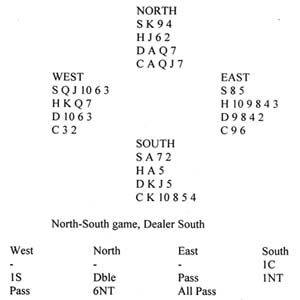|
Bridge
 North’s
double was negative (for take-out) and South’s 1NT rebid showed
15-17 points. North’s leap to 6NT was somewhat of an overbid, with
only 17 points and such a flat hand. He should have suggested a slam
with a limit raise to 4NT. How would you play 6NT when West leads the
queen of spades? There are eleven tricks on top and the only real
chance of a twelfth is to squeeze West in the major suits. In other
words, you will play your winners in the minors and force West to
weaken his guard in one or other major suit. Normally, for such a
squeeze, it would aid your prospects to duck a trick at an early
stage, to tighten the end position. You cannot duck a heart here
because West would then return another spade, leaving you with no
entry to dummy in the squeeze ending. Instead you must win the spade
lead with the ace and run your minor-suit winners straightaway. When
you play the last of them West will have to find one more discard from
J-10 of spades and K-Q of hearts. If he throws a spade, dummy’s K-9
will be worth two tricks. If instead he throws a heart, you will throw
the spade nine from dummy and then play ace and another heart to set
up dummy’s jack of hearts. It’s the sort of deal where someone who
knows little about squeezes might stumble onto the winning line. North’s
double was negative (for take-out) and South’s 1NT rebid showed
15-17 points. North’s leap to 6NT was somewhat of an overbid, with
only 17 points and such a flat hand. He should have suggested a slam
with a limit raise to 4NT. How would you play 6NT when West leads the
queen of spades? There are eleven tricks on top and the only real
chance of a twelfth is to squeeze West in the major suits. In other
words, you will play your winners in the minors and force West to
weaken his guard in one or other major suit. Normally, for such a
squeeze, it would aid your prospects to duck a trick at an early
stage, to tighten the end position. You cannot duck a heart here
because West would then return another spade, leaving you with no
entry to dummy in the squeeze ending. Instead you must win the spade
lead with the ace and run your minor-suit winners straightaway. When
you play the last of them West will have to find one more discard from
J-10 of spades and K-Q of hearts. If he throws a spade, dummy’s K-9
will be worth two tricks. If instead he throws a heart, you will throw
the spade nine from dummy and then play ace and another heart to set
up dummy’s jack of hearts. It’s the sort of deal where someone who
knows little about squeezes might stumble onto the winning line.
Answer
 In traditional-style
bidding you would have to rebid 3H, because 2H was non-forcing. This
leaves partner in a quandary because he has no idea whether you have
five hearts or only four. In tournament play, most partnerships treat
a rebid of 2H (but not 2S) as forcing for one round. This saves a lot
of space and prevents the ‘four or five’ problem that I mentioned. In traditional-style
bidding you would have to rebid 3H, because 2H was non-forcing. This
leaves partner in a quandary because he has no idea whether you have
five hearts or only four. In tournament play, most partnerships treat
a rebid of 2H (but not 2S) as forcing for one round. This saves a lot
of space and prevents the ‘four or five’ problem that I mentioned.
Awards: 2H (forcing)
- 10, 3H, - 7, 3NT - 4, 3S - 3.
David Bird
— Knight Features
|